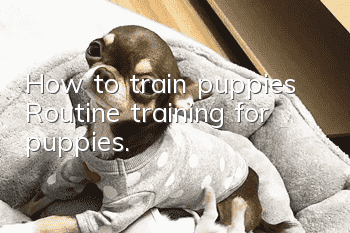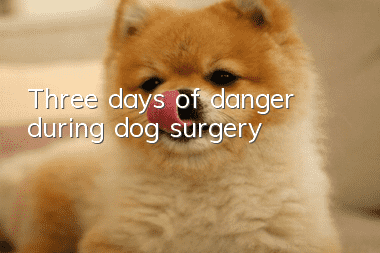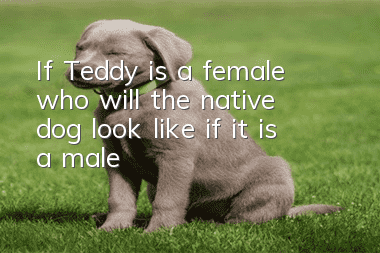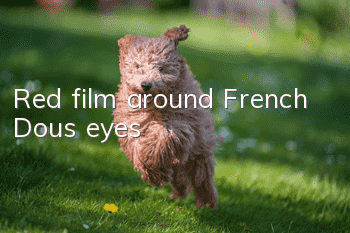How to train puppies? Routine training for puppies.

Develop the dog's ability to pick up objects
Many puppies are born lively and possessive, but they need further training in picking up various objects. At first, cotton fabrics can be used to tease the puppy, so that it will bite naturally and excitedly, and pretend to compete with the dog in a tug-of-war manner to encourage the dog and eventually let it win. On this basis, throw tennis balls, pick-up sticks and other items that the dog likes, let the dog pick them up excitedly, and give adequate rewards. Some dogs are not interested in objects, so they can use the methods of "bringing," "fishing," and "picking" to lure them until they pick them up.
"Leading" means to use the puppies that can pick up to lead the puppies that can't pick up, and let the latter watch and fight until they learn to pick up.
"Fishing" means tying cotton strips or balls to a rope, hanging them in mid-air with a pole or dragging them on the ground to arouse the puppies' curiosity and interest in the objects. When the dogs bite the objects, they become the same. Fishing shape.
"Pick up" means to observe the puppy at ordinary times, pick up the items it is interested in, wrap them in gauze, and let it pick them up.
It is generally better to cultivate the puppy's picking ability in the morning and on an empty stomach. The number of times the dog should be picked should not be too many, 2-3 times is enough to maintain its excitement for picking.
Cultivating dogs to be brave and aggressive
The cultivation of this characteristic must be carried out with the assistance of others. Commonly used training methods can be roughly divided into the following two types:
(1) Use the innate behavior of puppies to protect food to cultivate their courageous and offensive characteristics. Tie the puppy up and place a bowl of food next to it. Arrange for a stranger to lead the dog close to the food bowl. If the puppy barks due to its instinct to protect food, the owner should immediately praise the dog and drive away the stranger. , give the puppy a food bowl to encourage him to eat.
(2) Use the provocation of strangers and the encouragement of dogs to stimulate aggressive behavior in puppies. Multiple dogs are used to stand in an arc shape, and strangers wearing shabby clothes hold cotton strips, branches or hemp sticks in their hands to tease them continuously. When the dogs show signs of barking and chasing, the cotton or hemp sticks are given to the dogs in a timely manner. Biting and pulling. At this time, the owner should give the "good" command and gently stroke the dog's body with his hand as a reward. For timid puppies, owners should constantly provide encouragement and allow them to increase their confidence and desire to attack by observing the biting process of their companions. This training should end with the puppy winning every time to promote his desire to attack.
Cultivate the dog's adaptability to sound, light and environment
Puppies' environmental exercise should be carried out very early, in the spirit of clean first and then complex; first day and then night; first weak stimulation and then strong stimulation carried out in principle. Gradually transition from the environment that the dog is familiar with to training with complex environmental conditions such as noise, cars, horses, and pedestrians. Sound and light exercises should be carried out from small to large, from weak to strong, and from far to close. Sudden attacks must not be carried out, otherwise the puppies may develop "phobia". During sound, light and environmental exercise, if the puppy appearsWhen showing fear or searching for a reaction, you should not pull or force the dog. Instead, you should encourage the dog with pats and food. You should be patient and induce the dog to eliminate its doubts.
Training dogs to adapt to riding in vehicles
In dogs’ lives, they often encounter transportation by vehicles. Many dogs are not used to this, and some even get motion sickness and vomit, which seriously affects the dog's mental state and work quality. Therefore, necessary car riding exercises should be carried out during puppyhood. First, you can lead the puppies to the car, hold them in the car, let them move in the car for a while, so that they can slowly get used to it, then start the car and drive slowly, and then gradually speed up. The driving distance is from short to long, the road surface is first good and then bad, and the time is from short to long. The owner should stay with the puppy throughout the ride, provide comfort and encouragement, and pay attention to the dog's performance. If your puppy encounters motion sickness and vomiting, you should stop the vehicle immediately, take the puppy out of the vehicle and let it wander for a while, and take motion sickness medication if necessary.
Early development and training of puppies' sense of smell
The early development of puppies' sense of smell is of great significance to future training on olfactory subjects. In the early stages of puppy training, dogs are full of curiosity and exploration of various new environments in the outside world. If you can seize the opportunity and use the correct method to induce them, the dog will develop the habit of careful sniffing. WeChat public account: Dog training every day, there are several methods for early development and training of puppies’ sense of smell:
(1) When the puppy is stimulated by food and is hungry, scatter its favorite food on the grass. The puppy will look for food through sniffing and continue to improve through the rewarding effect of food. Excitability of sniffing.
(2) Use the objects that the puppies like to cultivate sniffing. Use the objects to tease them and then throw them into the grass to encourage the dogs to search for the objects through sniffing.
(3) As the sniffing ability of puppies improves, food stimulation should be reduced as much as possible, especially in the later stages. Concealed throwing object picking training is generally used to cultivate the dog's enthusiasm and endurance for searching.
6. Help puppies change bad habits
In the process of puppy training and training, although the puppies make unexpected progress, they will also bring about many bad habits. Dog trainers should understand the existence of these problems and do not get angry or reprimand. At this time, what the dog needs most is patient help.
In the process of puppy training and training, several bad habits that are prone to occur and their correction methods are as follows:
(1) A dog suddenly breaks away from the traction during training, does not listen to the owner's call, and runs back to the house. At this time, it is a common phenomenon that the dog is afraid of the new environment and avoids exercise. Therefore, a large number of games and encouragement should be incorporated into daily exercise and training to make learning easy and enjoyable and reduce stress to a minimum.
(2) Puppies all have the problem of picking up food everywhere. If it is allowed to develop, it is not conducive to its healthy growth. You should help it change this bad habit. The correct method is: place food on both sides of the road in advance, then lead the puppy to get close to it naturally, andPay attention to the dog's behavior. When the puppy sees food and wants to open its mouth to pick up the food, immediately give the "no" command and at the same time pull the leash sharply to stimulate the dog.
(3) As puppies develop their bravery, they will become more and more aggressive, and they will also develop bad behaviors of chasing and biting people and animals for no reason. Usually, the dog should be consciously led to walk beside people and livestock. If the dog behaves aggressively, the dog should be stimulated by pulling on the leash. After correction, the dog should be rewarded with a pat and a "good" command. Repeated training in this way allows the dog to gradually adapt to humans and animals until it no longer reacts violently.
- How much does a teacup dog cost? Rare breeds, don’t be fooled!
- Why do dogs howl before they die? Maybe they are expressing their love for you.
- What should I do if my dog vomits after not knowing what he has eaten?
- Can pancreatitis in dogs be cured? Never give up when your dog is sick.
- Dogs can get pregnant again every few months. The timing needs to be accurately controlled.
- Why do dogs hide food? You may not feed your dog on time!
- Dog keeps spinning in circles. Nervous problem. Don’t you know what it means when a dog keeps spinning in circles?
- How long does it take for a dog to show internal injuries after being hit by a car? Pay attention to your dog when crossing the road and don’t patronize yourself.
- How to treat motion sickness in dogs Four-step training method
- What should you pay attention to when walking your dog? Have you ever committed these 6 taboos when walking your dog?



